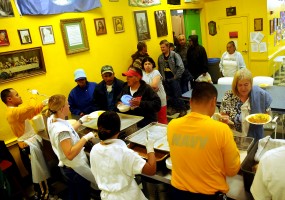I’ve just returned from speaking at the first ever Central Oregon Arts Summit in Bend, OR. It was a great (and quick) trip to a place that appears to be reaping the benefits of over twenty years of active work cultivating a public policy climate favorable to the arts. As one demonstration, the voters of Bend recently approved a hotel tax dedicated to supporting the arts and culture.
 Travel and speaking with peers from around the country always provides new insights and new ways of thinking about old things. Several popped up on this trip, but let me begin with an observation about an old chestnut for us in the arts. “Outreach” has been part of our vocabulary for generations. I’ve often shared my misgivings about the word in passing in Q&A sessions following presentations I make. I’ve even mentioned my concern in this blog (Outreach and Audience Engagement):
Travel and speaking with peers from around the country always provides new insights and new ways of thinking about old things. Several popped up on this trip, but let me begin with an observation about an old chestnut for us in the arts. “Outreach” has been part of our vocabulary for generations. I’ve often shared my misgivings about the word in passing in Q&A sessions following presentations I make. I’ve even mentioned my concern in this blog (Outreach and Audience Engagement):
I’ll admit it. I have a bad attitude about the word “outreach” in the context of the arts. Whether that attitude is rooted in the way the word has been used or in some quality inherent in it is not clear to me. I have difficulty with what often seem to be paternalistic activities undertaken in its name. . . . I know I am not alone in discomfort with the word because some organizations have banished it (officially or unofficially) from their vocabulary.
But in Bend, for the first time, I included reference to this concern in the text of my presentation:
Let me stop here and mention that the word outreach is one of my personal pet peeves. It is well-intentioned, but it has the effect of placing the “outreacher” in the center. There is an implicit assumption, though usually not intended, that those that are out need to come in. It can have the effect of placing extra distance between the arts organization and its community.
Much to my surprise, this was one of the most talked-about aspects of my remarks. Many commented on their struggle to find another word. My immediate response was that I was simply attempting to illuminate a potential danger in unexamined understandings of that word but that there was nothing wrong in much of the thought intended by it. I still believe that . . . mostly. However, as I’ve examined it, I’m becoming convinced that another issue with “outreach” is the potential it has for unconsciously reflecting a view that the one “who has much” is going out to help the one who has little. (Hence, the photo used in this post.) This sets up an inequality in relationship that can make meaningful engagement difficult. While I’ve not yet arrived at a good alternative word, most people’s true motivation lies in building relationships with new communities. Something like friend-making, while horribly inelegant, is more to the point. (If “disciple making” is more to your liking, beware of your motivations!) Effective engagement must be reciprocally beneficial. Doing “to” or “for” does not build deep relationships. Doing “with” is the best approach.
And this thought has sent me off on a new tangent having to do with similar issues regarding other vocabulary we in the arts use without a second thought. Be warned. That’s the subject of my next post.
Engage!
Doug
Photo from Wikipedia: http://en.wikipedia.org/wiki/Soup_kitchen
